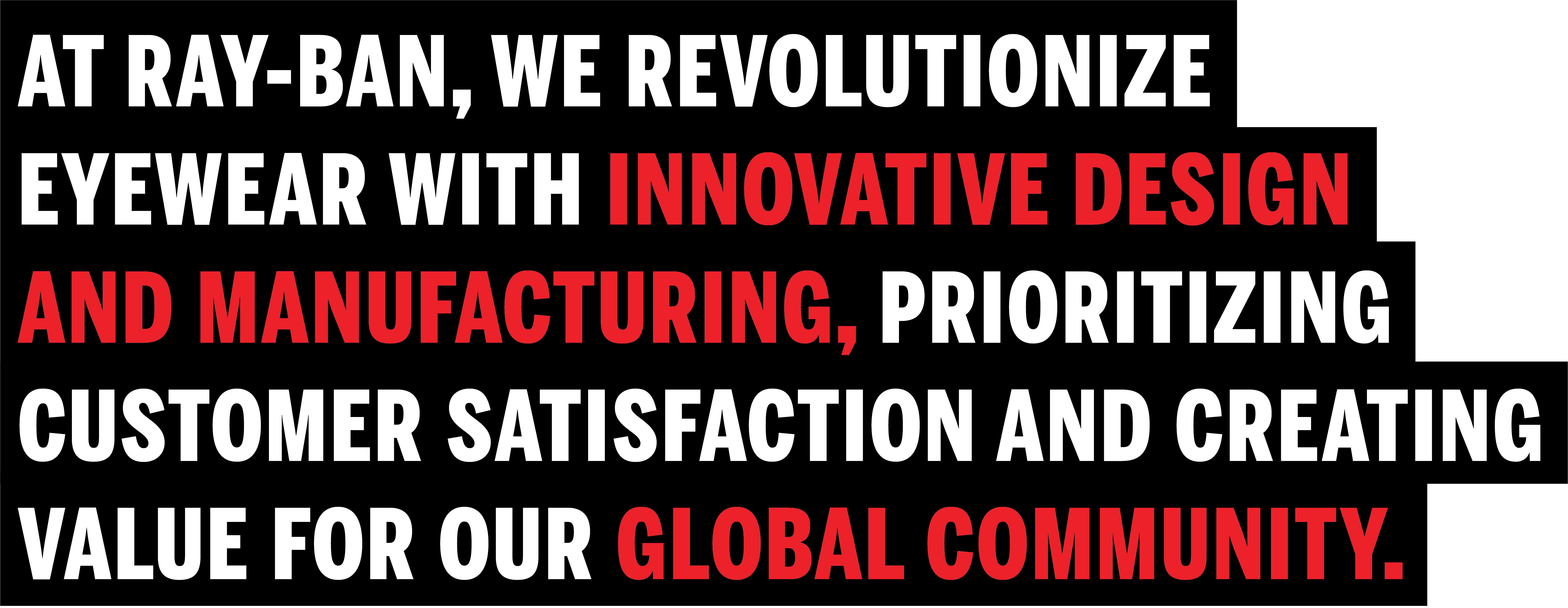
FOR EVERY MOMENT, THERE'S A
RAY-BAN
Defining the Decades
Through the passage of decades, Ray-Ban has stood as an enduring icon in the world of fashion eyewear. As trends ebbed and flowed, this brand remained a steadfast symbol of style and sophistication. With a timeless appeal that transcended generations, Ray-Ban carved its place into fashion history. It was not just eyewear; it was a statement of individuality, an emblem of enduring charm, and a testament to exceptional quality.
Ray-Ban’s influence extended far beyond the realms of fashion. From the spotlight of the stage to the bustling streets of urban life, it became an integral part of culture. Wearing Ray-Ban wasn’t just a choice; it was a statement of identity.
As we turn the pages of 2025, this reflection becomes a compass for the future. Ray-Ban’s journey offers strategic insights into the art of staying relevant in a swiftly changing world. It’s a testament to the brand’s ability to anticipate shifts in cultural winds and, in turn, influence them.
1930
Take Off Time
As new airplanes allowed people to fly higher and farther, many US Air Force pilots were reporting that the glare from the sun was giving them headaches and altitude sickness. A new kind of glasses were introduced with green lenses that could cut out glare without obscuring vision, and the Ray-Ban brand was born.
The original glasses featured a plastic frame with the now classic Aviator shape. It wasn’t long before the popularity of Ray-Ban spread from pilots to anyone with an outdoor lifestyle.
1940
Innovation Era
Pilot technology came back down to earth, expanding the range for police officers and champions of the outdoors. Military influence on fashion was undeniable: Army and Navy regulation t-shirts were a staple of 1940s fashion, and civilians eager to emulate pilots sported cool new sunglasses. Ray-Ban had jumped decisively from military function to pop culture fashion–without losing any of their trademark effectiveness.
The original glasses featured a plastic frame with the now classic Aviator shape. It wasn’t long before the popularity of Ray-Ban spread from pilots to anyone with an outdoor lifestyle.
Pilot technology came back down to earth, expanding the range for police officers and champions of the outdoors. Military influence on fashion was undeniable: Army and Navy regulation t-shirts were a staple of 1940s fashion, and civilians eager to emulate pilots sported cool new sunglasses. Ray-Ban had jumped decisively from military function to pop culture fashion–without losing any of their trademark effectiveness.

1950
Golden Age
In the wake of WWII, Hollywood was having an increasingly powerful impact on what people wore. On screen legends such as James Dean and Audrey Hepburn helped make the Ray-Ban Wayfarer one of the most instantly recognizable fashion accessories ever.
With an influx of new groundbreaking materials, Ray-Ban shifted from military function to everyday fashion. A dedicated women’s range was introduced in 1958, including frames in different colors with decorative flourishes that kept pace with contemporary fashion.
In the wake of WWII, Hollywood was having an increasingly powerful impact on what people wore. On screen legends such as James Dean and Audrey Hepburn helped make the Ray-Ban Wayfarer one of the most instantly recognizable fashion accessories ever.
1960
Free Love
Enter the age of individual expression. Ray-Ban became the see and be seen sunglasses, launching all kinds of different shapes and styles. Ray-Ban continued to create new styles and Hollywood stars continued to wear them.
Bob Dylan was rarely seen without his Ray-Ban Wayfarer, the dark lenses adding to his enigmatic non-conformist appeal. From roughly thirty models at the beginning of the decade, the catalog had expanded to fifty by 1969, including styles for men, women and children.
Enter the age of individual expression. Ray-Ban continued to create new styles and Hollywood stars continued to wear them. Bob Dylan was rarely seen without his Ray-Ban Wayfarer, the dark lenses adding to his enigmatic non-conformist appeal. The catalog expanded to fifty by styles 1969.
1970
Sports Scene
With new mirrored, tinted and light responsive lenses, Ray-Ban became a frontrunner in the sport’s world with flamboyant ‘70s style.
Ray-Ban launched two models, the Ray-Ban Vagabond and Ray-Ban Stateside. Re-introduced in 2010, the Ray-Ban Vagabond was updated with slightly teardrop-shaped lenses for a cool, retro look.

1980
Silver Screen
In the decade of arcade games, MTV, and the Brat Pack, Ray-Ban was one of the must-have brands. In the movies, there were leading roles for Ray-Ban Wayfarer. Top Gun (1986) took Ray-Ban Aviator back to their fighter pilot roots, boosting sales of the Ray-Ban original.
Michael Jackson established his signature look when he showed up at the 1984 Grammy’s in a pair of Ray-Ban Aviators. But it was Ray-Ban Wayfarer he chose for his epic Bad tour, which ran from 1987-89.
1990
Digital Evolution
Style, music, technology – all was booming, as was Ray-Ban. With a surge in popularity, Ray-Ban became the fashion statement of choice, symbolizing a cultural phenomenon embraced by trendsetters worldwide.
In 1999 Luxottica Group acquired the Bausch & Lomb frames business, including the brands Ray-Ban, Arnette, Killer-Loop Eyewear and REVO.
Style, music, technology – all was booming, as was Ray-Ban. With a surge in popularity, Ray-Ban became the fashion statement of choice, symbolizing a cultural phenomenon embraced by trendsetters worldwide.
2000
New Millennium
Bringing in the 2000s with a bang. Ray-Ban launched their very first Optical and Junior models in true trailblazing spirit, drawing on the brand’s pop culture heritage and meticulous craftsmanship to create contemporary eyewear infused with Ray-Ban lifestyle and quality.
Ray-Ban re-works its most iconic models in an explosion of fresh color for 2009 with the Never Hide, Colorize Communication Campaign.
Bringing in the 2000s with a bang. Ray-Ban launched their very first Optical and Junior models in true trailblazing spirit, drawing on the brand’s pop culture heritage and meticulous craftsmanship to create contemporary eyewear.
2010
Viral Decade
Adding an individual twist to the age of the selfie, Remix became the first ever customizable Ray-Ban. Also launching their creative hub Studios, Ray-Ban mixed with the most stylish musicians around.
In 2012, 75 years after the first pairs of Ray-Ban Aviator helped US pilots reach new heights, Ray-Ban remains an enduring classic.
FOR EVERY MOMENT, THERE'S A
RAY-BAN
Defining the Decades
Through the passage of decades, Ray-Ban has stood as an enduring icon in the world of fashion eyewear. As trends ebbed and flowed, this brand remained a steadfast symbol of style and sophistication. With a timeless appeal that transcended generations, Ray-Ban carved its place into fashion history. It was not just eyewear; it was a statement of individuality, an emblem of enduring charm, and a testament to exceptional quality.
Ray-Ban’s influence extended far beyond the realms of fashion. From the spotlight of the stage to the bustling streets of urban life, it became an integral part of culture. Wearing Ray-Ban wasn’t just a choice; it was a statement of identity.
As we turn the pages of 2025, this reflection becomes a compass for the future. Ray-Ban’s journey offers strategic insights into the art of staying relevant in a swiftly changing world. It’s a testament to the brand’s ability to anticipate shifts in cultural winds and, in turn, influence them.
1930
Take Off Time
As new airplanes allowed people to fly higher and farther, many US Air Force pilots were reporting that the glare from the sun was giving them headaches and altitude sickness. A new kind of glasses were introduced with green lenses that could cut out glare without obscuring vision, and the Ray-Ban brand was born.
The original glasses featured a plastic frame with the now classic Aviator shape. It wasn’t long before the popularity of Ray-Ban spread from pilots to anyone with an outdoor lifestyle.
1940
Innovation Era
Pilot technology came back down to earth, expanding the range for police officers and champions of the outdoors. Military influence on fashion was undeniable: Army and Navy regulation t-shirts were a staple of 1940s fashion, and civilians eager to emulate pilots sported cool new sunglasses. Ray-Ban had jumped decisively from military function to pop culture fashion–without losing any of their trademark effectiveness.
The original glasses featured a plastic frame with the now classic Aviator shape. It wasn’t long before the popularity of Ray-Ban spread from pilots to anyone with an outdoor lifestyle.
Pilot technology came back down to earth, expanding the range for police officers and champions of the outdoors. Military influence on fashion was undeniable: Army and Navy regulation t-shirts were a staple of 1940s fashion, and civilians eager to emulate pilots sported cool new sunglasses. Ray-Ban had jumped decisively from military function to pop culture fashion–without losing any of their trademark effectiveness.

1950
Golden Age
In the wake of WWII, Hollywood was having an increasingly powerful impact on what people wore. On screen legends such as James Dean and Audrey Hepburn helped make the Ray-Ban Wayfarer one of the most instantly recognizable fashion accessories ever.
With an influx of new groundbreaking materials, Ray-Ban shifted from military function to everyday fashion. A dedicated women’s range was introduced in 1958, including frames in different colors with decorative flourishes that kept pace with contemporary fashion.
In the wake of WWII, Hollywood was having an increasingly powerful impact on what people wore. On screen legends such as James Dean and Audrey Hepburn helped make the Ray-Ban Wayfarer one of the most instantly recognizable fashion accessories ever.
1960
Free Love
Enter the age of individual expression. Ray-Ban became the see and be seen sunglasses, launching all kinds of different shapes and styles. Ray-Ban continued to create new styles and Hollywood stars continued to wear them.
Bob Dylan was rarely seen without his Ray-Ban Wayfarer, the dark lenses adding to his enigmatic non-conformist appeal. From roughly thirty models at the beginning of the decade, the catalog had expanded to fifty by 1969, including styles for men, women and children.
Enter the age of individual expression. Ray-Ban continued to create new styles and Hollywood stars continued to wear them. Bob Dylan was rarely seen without his Ray-Ban Wayfarer, the dark lenses adding to his enigmatic non-conformist appeal. The catalog expanded to fifty by styles 1969.
1970
Sports Scene
With new mirrored, tinted and light responsive lenses, Ray-Ban became a frontrunner in the sport’s world with flamboyant ‘70s style.
Ray-Ban launched two models, the Ray-Ban Vagabond and Ray-Ban Stateside. Re-introduced in 2010, the Ray-Ban Vagabond was updated with slightly teardrop-shaped lenses for a cool, retro look.

1980
Silver Screen
In the decade of arcade games, MTV, and the Brat Pack, Ray-Ban was one of the must-have brands. In the movies, there were leading roles for Ray-Ban Wayfarer. Top Gun (1986) took Ray-Ban Aviator back to their fighter pilot roots, boosting sales of the Ray-Ban original.
Michael Jackson established his signature look when he showed up at the 1984 Grammy’s in a pair of Ray-Ban Aviators. But it was Ray-Ban Wayfarer he chose for his epic Bad tour, which ran from 1987-89.
1990
Digital Evolution
Style, music, technology – all was booming, as was Ray-Ban. With a surge in popularity, Ray-Ban became the fashion statement of choice, symbolizing a cultural phenomenon embraced by trendsetters worldwide.
In 1999 Luxottica Group acquired the Bausch & Lomb frames business, including the brands Ray-Ban, Arnette, Killer-Loop Eyewear and REVO.
Style, music, technology – all was booming, as was Ray-Ban. With a surge in popularity, Ray-Ban became the fashion statement of choice, symbolizing a cultural phenomenon embraced by trendsetters worldwide.
2000
New Millennium
Bringing in the 2000s with a bang. Ray-Ban launched their very first Optical and Junior models in true trailblazing spirit, drawing on the brand’s pop culture heritage and meticulous craftsmanship to create contemporary eyewear infused with Ray-Ban lifestyle and quality.
Ray-Ban re-works its most iconic models in an explosion of fresh color for 2009 with the Never Hide, Colorize Communication Campaign.
Bringing in the 2000s with a bang. Ray-Ban launched their very first Optical and Junior models in true trailblazing spirit, drawing on the brand’s pop culture heritage and meticulous craftsmanship to create contemporary eyewear.
2010
Viral Decade
Adding an individual twist to the age of the selfie, Remix became the first ever customizable Ray-Ban. Also launching their creative hub Studios, Ray-Ban mixed with the most stylish musicians around.
In 2012, 75 years after the first pairs of Ray-Ban Aviator helped US pilots reach new heights, Ray-Ban remains an enduring classic.


